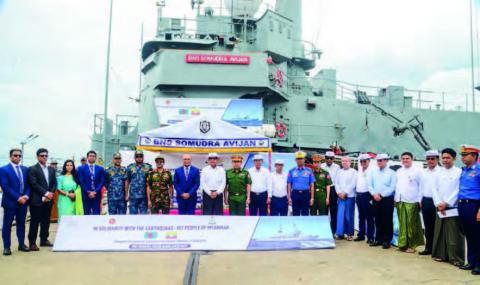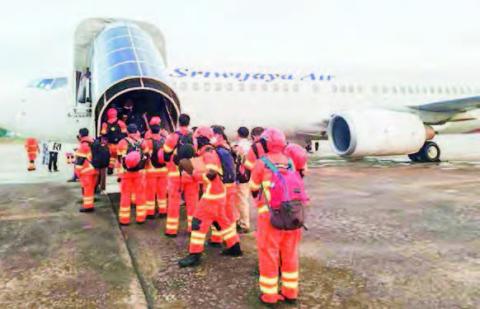Earthquake Diplomacy: Extending a helping hand to Myanmar through humanitarian ground
Thet Mon Tun
THE international community’s earthquake relief support to Myanmar depicts true compassion, solidarity, and commitment to a shared future.
The Mandalay Earthquake that struck Myanmar in late March claimed 3,763 lives and injured 5,107 people, with 110 still reported missing as of 24 April, causing widespread devastation across major urban areas, especially in central Myanmar.
The disaster consisted of two consecutive quakes: the first, a powerful 7.7-magnitude tremor, struck near Sagaing. Within just seconds, a second quake measuring 6.9 in magnitude was shaking with its epicentre near TadaU, Mandalay. Therefore, Mandalay, Nay Pyi Taw and Sagaing were impacted the most devastation of the quake, where the former two cities are economically and executively important to the country.
The National Disaster Management Committee (NDMC) announced, as of 19 April, that a total of 65,096 residential housings; 2,514 schools, 4,317 monasteries and nunneries; 6,027 religious sites including pagodas, temples and stupas; 350 healthcare areas including public hospitals and clinics; 38 locations on the rail transportation system; 269 roads; 203 sites on the Yangon-Mandalay Expressway; 586 dams and water reservoirs, and 170 bridges across the country were damaged by the quake.
Chairman of the State Administration Council, Senior General Min Aung Hlaing, immediately requested international aid to remedy the heavy casualties and devastation of the country amid the quake. The call was quickly responded to by the international community. Neighbouring countries such as China, Thailand and India; friendly nations such as Russia and Belarus, ASEAN nations; many countries that build diplomatic relations with Myanmar, and international organizations such as UNICEF and WHO poured in their helping hands to Myanmar.
“Dealing with disasters typically pushes diplomatic relations along the pathway which it was on before,” Professor Ilan Kelman remarked concerning disaster diplomacy in an interview with Business Insider in 2018. In this regard, many presidents, prime ministers, military leaders, top diplomats and top leaders of many countries sent their condolences to Myanmar day by day through various channels following the powerful earthquake.
The very first, Russian President Vladimir Putin stated his condolences to Myanmar in a statement published on the Kremlin’s website, underlining his deepest condolences on the tragic consequences of the earthquake in Sagaing and Mandalay regions and stating that Russia shares the grief of the friendly people of Myanmar, the Russian media reported.
Consequently, on the next day, Senior General Min Aung Hlaing received phone calls and letters from world leaders expressing their condolences to Myanmar. It witnessed the extensive diplomatic activities with Myanmar in the international diplomatic realm.
What is more, as per Professor Ilan Kelman, it is learned that: “the diplomatic efforts following such events (disasters) can serve as a catalyst for the thawing of political and diplomatic relations between nations,” and “the evidence from disaster diplomacy studies suggests that disaster-related activities do not create fresh diplomatic opportunities, but that they have the possibility for catalyzing diplomatic action.”
On this point, the 6th Bay of Bengal Initiative for Multi-Sectoral Technical and Economic Cooperation (BIMSTEC) Summit was held in Bangkok, Thailand, from 2 to 4 April 2025. It marked the first in-person meeting of BIMSTEC leaders since 2018. The Myanmar delegation, led by Senior General Min Aung Hlaing, participated in the summit and related side events. The summit focused on enhancing prosperity, resilience, and openness for the region’s 1.7 billion people. During the meetings, BIMSTEC leaders held a minute of silence to express their condolences for the recent tremor that happened in Myanmar and Thailand.
During the BIMSTEC meetings, Senior General Min Aung Hlaing extended additional requests to the international community to reinforce resettlement operations in Myanmar for the post-earthquake trauma. He met with the current BIMSTEC Chair, Thailand Prime Minister Paetongtarn Shinawatra and Indian Prime Minister Shri Narendra Modi ahead of the BIMSTEC meetings discussed domestic situations of the socio-political landscape, and exchanged views on disaster management.
The BIMSTEC leaders issued a joint statement on the impact of the earthquake on 4 April. It bolsters the solidarity of the regional bloc in supporting the mechanism of relief and recovery efforts, including collaboration through the BIMSTEC Centre for Weather and Climate to provide critical weather information and enhance early warning systems in the region. The efforts of the BIMSTEC member states in providing humanitarian assistance and disaster relief to Myanmar had been appreciated in the bloc statement.
In addition, Prime Minister Senior General Min Aung Hlaing met with Malaysian Prime Minister Anwar Ibrahim, the rotational chair of ASEAN 2025, in Bangkok, Thailand, on 17 April. The meeting highlighted the extensive collaboration of the bloc in the relief of Myanmar from the earthquake disaster.
It is highly challenging for the people of Myanmar to be resilient in this catastrophe with huge destruction unexpectedly, in addition to the multi-sectoral hardships on social, economic and political grounds in the meanwhile.
Worse again, hundreds of aftershocks ranging from mild to severe with magnitudes between 3.0 and 5.5 continued shaking the country until mid-April every day. Every aftershock reportedly struck with a shallow depth of around 10 kilometres or below, intensifying their impacts. During these three weeks, there was no such day on which the aftershocks did not strike the regions alongside the Sagaing Fault, as well as in surrounding areas near the Kyaukkyan Fault and other smaller faults in Shan State.
Sagaing Fault: The seismic activity of the 1,200-kilometre-long Sagaing Fault is highly active. It is responsible for major earthquakes in Myanmar’s history, such as the Bago Earthquake with a 7.3-magnitude in 1930 and the Mandalay Earthquake with a 7.7-magnitude in 1946. Since the fault passes through the urban area with high population density, and it runs north-south through the country, further studies have to be conducted later. Therefore, many external geologists and seismologists should conduct further studies on these deadly active tectonic plates.
Over the past weeks, rescuers, medical teams, and shipments of relief and humanitarian supplies from various countries have been arriving in Myanmar, batch by batch. As of 17 April, rescue workers, medical teams, Red Cross personnel, and humanitarian aid workers from 25 countries have been actively involved in rescue and resettlement operations in Myanmar following the earthquake.
“A total of 1,956 rescuers, 2,332 tonnes of humanitarian supplies and 1,170 tonnes of relief and rescue assistance from 25 countries have been received through 136 flights,” Maj-Gen Zaw Min Tun shared the information with the media on 17 April.
Senior General Min Aung Hlaing’s immediate declaration of emergencies and request for international assistance following the devastating tremor, which truly was part of effective disaster management, and the spontaneous responses of the international community on humanitarian grounds truly saved many souls and properties.
A total of 653 lives were rescued and 754 bodies were found by Myanmar Fire Brigade personnel and foreign rescuers as of 18 April. Amongst, eight lives were saved and 203 bodies were discovered by the foreign rescuers, according to the NDMC.
The people of Myanmar express our deepest gratitude to every nation, humanitarian organization, and international body that reached out to help us during our nightmare of this earthquake disaster. Every support of the international community has touched our hearts overwhelmingly.
In summary, the earthquake in Myanmar on 28 March not only caused enormous suffering for the people of Myanmar, but it was also observed blessing in disguise. The recent earthquake disaster renewed engagement in addressing urgent humanitarian needs. The increased international aid witnessed a true compassion of caring and sharing in the essence of the shared future.
#TheGlobalNewLightOfMyanmar


